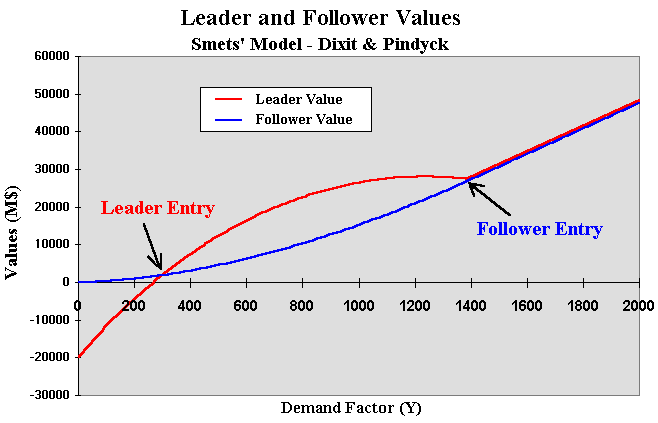
Answer: It is necessary to use the option-games approach, the combination of the real options with game-theory
The real options approach is necessary but not sufficient in this case. The Game Theory provides the way to consider the strategic iteration with the competitors. The combination of these two approached is named "option games" (Lambrecht & Perraudin, 1994).
I present two examples of timing games, that in
game-theory are named "preemption game" and "war of
attrition", respectively.
See also the webpage "option games"
for more details.
This is perhaps the most classic option-game model, due the doctoral dissertation of Smets at Yale and summarized by the Dixit & Pindyck textbook (chapter 9). Assumptions of the model:
The chart below presents the leader and follower values.

The leader entry threshold is given when both players are indifferent about to be the leader or the follower (same value for both). Note that the leader at the threshold level the NPV > 0, but the project doesn't need to be too "deep-in-the-money" as in the monopolistic case.
After the leader entry in the market, in this model the follower entry-threshold is like the monopolistic case.
This example, from Dias (1997), describes the waiting game of drilling in petroleum exploration.
Consider two companies, X and Y, with neighbor tracts and correlated oil prospects. See the picture below.

There is an information externality in this case, the drilling of one firm reveal information for the other firm (the free-rider):
Here the effect of the competitor presence is the opposite of the
duopoly case presented before: the presence of the other firm
increases the value of waiting to invest!
The waiting for a free information is the additional effect compared with
the traditional real options model without competitors.
In these cases the effect of the competition is clear. In others cases this is not so clear. For example, to entry with a new product in the market: sometimes there is a "first move advantage" in the sense that the first firm gets a large market share than the followers; but sometimes the economic literature reports the "second move advantage" in the sense that the follower learns with the errors of the first mover. In the second case the information externality is used like a market test, and the follower learns about the market size, consumers preferences, and so on.
![]()